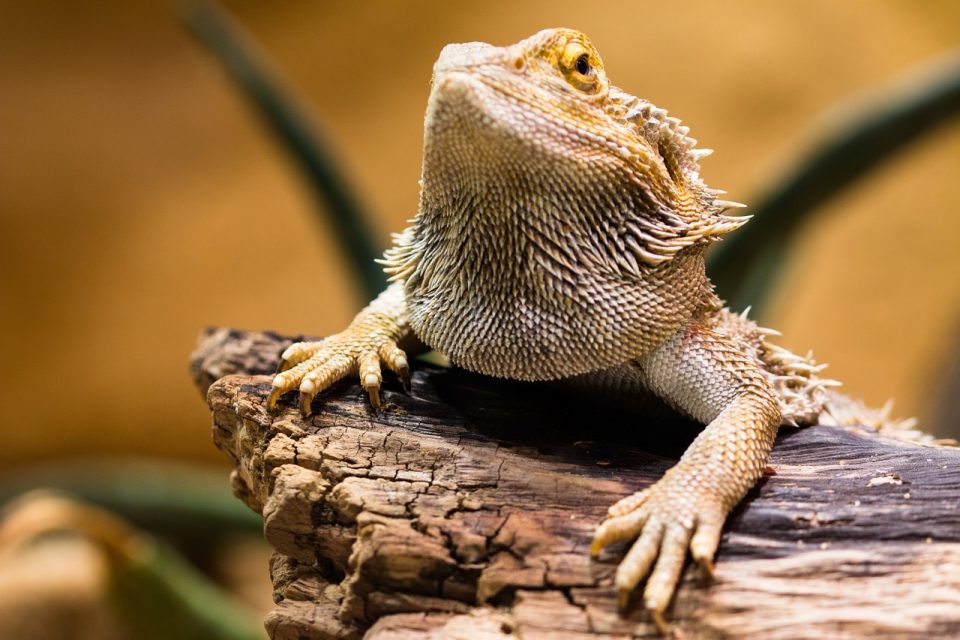One of the main things to consider before getting any pet is how big they will get in the future.
Sure, bearded dragons may start out small and cute, but, unlike the myth that states they will grow to the size of their enclosures, bearded dragons can grow large – fast.
Whether you just purchased your first beardie or you’re considering purchasing one in the near future, it’s important to understand just how big they will be at different life stages.
By preparing early and understanding just how big a dragon can get, you will be ready to buy a tank that will support your bearded dragon from youth to adulthood.
Understanding How Bearded Dragons Grow
While it’s recommended to go ahead and purchase an enclosure capable of housing an adult bearded dragon, if you’re more interested in sizing up as your beardie grows, it’s important to understand how fast they grow and about how long they will be at each age.
This helps you accurately prepare to give your beloved reptile the home they deserve so that they can continue to grow – which they will for up to two years!
Average Sizes at Different Ages
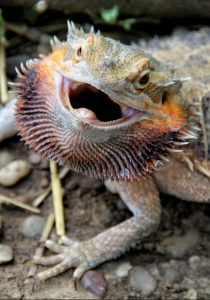 Like with any animal, a bearded dragon’s size depends on its age. They can start off as small as a few inches and quickly grow up to two feet or even larger!
Like with any animal, a bearded dragon’s size depends on its age. They can start off as small as a few inches and quickly grow up to two feet or even larger!
In fact, there are certain breeds of bearded dragons that, under the right conditions, can grow up to 29 inches long.
If that number is bit scary, don’t worry – it’s actually really uncommon for anyone to have a beardie grow that large.
Instead, the most common breed – the Pogona vitticeps – only grows up to around 24 inches, a length that takes them two years to achieve.
The Baby Months
In their first month, you’ll find that they can grow up to 4 inches long. At the end of the next month, you may find that your bearded dragon has already grown up to 9 inches long.
The next month, 11 inches, then 12 inches, and at 5 months old, the last of the baby months, you’ll find that your bearded dragon may have grown to be 16 inches long.
The Juvenile Months
The juvenile months last from when your beardie is 6 months old to 1 year old. During their first month as a juvenile, you may see your bearded dragon grow from 16 inches long to 18 inches.
After that, however, you may notice that growth has slowed down drastically.
Your bearded dragon may only grow up to an extra inch a month, if that, until they are an adult, resulting in him or her being 22 inches long.
The Adult Months
The adult months are technically the rest of your bearded dragon’s life.
However, you will only see growth for the next year where he or she will only grow and additional 2 or so inches.
This means that an adult bearded dragon is usually around 24 inches long once they reach their full size.
How Fast do Bearded Dragons Grow?
While you may see an additional two or so inches of growth during your bearded dragon’s second year of life, it is the first year that makes all the difference in the size of our bearded dragon – as you can see from the lengths listed above.
By the end of their first year, most beardies will almost be at their adult size, and, if they’re not, you’ll be able to estimate about how large they will grow to be.
Of course, while the final length that your adult bearded dragon will reach depends on a variety of factors such as breed, genetics, and health, most will grow to be around 20 inches in their first year, reaching anywhere from 22 inches to 24 inches at the end of their second year.
While this may not seem like a significant difference, in your dragon’s first year, you’ll find they can grow up to 5 inches in one month! Babies (0 to 5 months) have the fastest growth rate while it slows down for juveniles (6 to 12 month) and slows down even further for adults (12+ months).
What Influences the Growth of Bearded Dragons?
Just like humans, growth is dependent on a lot of factors, some which cannot be controlled.
Breed
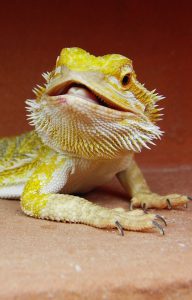 Not all bearded dragons are created equal. In fact, there are over eight species of bearded dragons, each one growing to a different size.
Not all bearded dragons are created equal. In fact, there are over eight species of bearded dragons, each one growing to a different size.
The Central Bearded Dragon and the Coastal Bearded Dragon tend to grow to a maximum of 24 inches while some smaller varieties like the Drysdale River Bearded Dragon will only grow to be 6 inches!
If you’re looking for something more in the middle, the Mitchells Bearded Dragon and the Western Bearded Dragon both only grow up to 18 inches.
Sex
Like with most species, female bearded dragons are usually smaller than their male counterparts.
However, this is not definite, and, with the proper nutrition and environment, a female beardie can indeed grow larger than a male.
As a reminder, size is not a proper tool when it comes to sexing your bearded dragon.
Lifestyle and Health
This is the factor that you can control – and it’s one of the most important.
By making sure your bearded dragon is properly cared for, you can help them reach their maximum size, just like with a human baby.
Beardies need certain environmental elements such as a special UVB light and heat source as well as certain amounts of vitamins and proteins to help them grow.
How to Care for Your Bearded Dragon for Proper Growth
The Proper Diet for Bearded Dragons
When it comes to feeding your bearded dragon the right diet to ensure they grow healthy and strong, age matters.
Hatchlings and juveniles need different nutrition than an adult beardie as they are still growing.
What to Feed Younger Bearded Dragons
Younger bearded dragons, as you saw above, have a lot of growing to do before they are adults.
This means that they need a diet that is high in protein and fats while still also maintain the amount of veggies and greens they need to be healthy.
Most younger beardies will want to eat insects – try feeding them two to three times a day in 15-minute intervals.
While it may seem that all they want to eat is insects, it’s important to encourage your young bearded dragon to eat some vegetables as well to maintain their overall health.
The best way to do this is to keep vegetable and fruits available in the enclosure at all times, replacing often to keep them fresh.
Your bearded dragon may like one fruit or vegetable over another, so try to experiment with different combinations if you notice that most of the food you provide is going to waste.
What to Feed Older Bearded Dragons
As your bearded dragon ages and their growth slows, you’ll find that they’re not as interested in the fatty, protein-rich insects as they were when they were a hatchling.
This is because their main goal has become simply to sustain a healthy life rather than growing.
Now, rather than feeding your beardie insects two to three times in a single day, you should only feed them insects every one or two days.
Like before, though, you should make sure that they have a steady source of fruits and vegetables available for them at all times.
Best Insects to Feed to Bearded Dragons
Thankfully, beardies aren’t picking eaters, making feeding them a piece of cake.
Most youngsters will eat any bug that you put in front of them, but there are a few that are agreed upon to be both healthy and liked by beardies. These include:
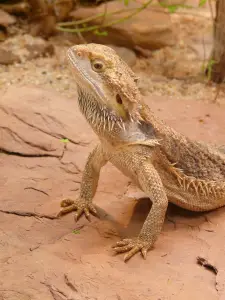 Black soldier fly larvae
Black soldier fly larvae- Different types of worms such as:
- Earthworms
- Redworms
- Superworms
- Butterworms
- Crickets
- Cockroaches
- Dubia Roaches
- Locusts
When feeding your beardie insects, it’s important to take precautions to make sure that they do not overeat or fill up so much on insects that he or she is unable to eat the fruits and vegetables that they also need to sustain their health and boost their growth.
As a rule of thumb, make sure to monitor your bearded dragon during feedings, which, as a reminder, should be two to three times a day for hatchlings and juveniles and once every two or so days for adults.
The best way to feed your beardie is to allow them to eat as many insects as they desire in a 15 minute period.
After that 15 minute period is over, capture and remove any remaining bugs for later.
If you fail to remove them from the enclosure, you may find that you have issues later one with a pest infestation within your bearded dragon’s enclosure or unhealthy weight gain in your beardie due to them making midnight snacks out of their new tank-mates.
Best Fruits and Vegetables to Feed to Bearded Dragons
By the time your beardie is an adult, fruits and vegetables should make up the majority of their diet.
However, when you’re first switching their diet, it can be hard to find greens that your beardie likes.
Thankfully, they can eat a wide variety of fruits and vegetables, allowing you to experiment to see what they like best. Some of the most common fruits and veggies include:
- Collard and Mustard Greens
- Bell Peppers
- Squash
- Watermelon (only varieties without seeds)
It’s recommended that you use fresh fruits and vegetables whenever you can. While frozen food isn’t terrible for your beardie, it lacks the nutrition.
You also don’t have to cook your beardies food – they’re happy eating it raw! – but if you find they’re struggling to eat it due to it being too hard, you can cook it to soften it.
Just make sure to let it cool back to room temperature before you serve it. Unlike insects, it is safe – and even recommended! – for you to leave fresh fruits and vegetables in the tank at all times.
This encourages your bearded dragon to eat more plants, though, adults often don’t need this extra encouragement.
Of course, make sure to replace the vegetation often so that it does not spoil.
What Not to Feed Your Bearded Dragon
One of the best and worse things about bearded dragons is that they’re not picky eaters – in fact, they’ll eat just about anything that happens to make its way into their enclosure.
Of course, this also means that they sometimes can get their hands on food that can harm them.
Make sure that when you feed your bearded dragons insects, you avoid these listed below, as they can harm your beardie:
- Any bioluminescent bugs such as fireflies
- Insects with venom and/or stingers
- Insects that you found and cannot identify
- Fishing bait insects
- Insects found in your home or outside
To make this simple, it’s best just to avoid any insect that hasn’t come directly from a certified supplier.
Insects that aren’t properly grown just for the purpose of being used as bearded dragon food may contained pesticides or parasites that can harm your beardie.
Choosing the Right Enclosure for Your Bearded Dragon
While it is an option to start with a smaller enclosure such as a 20 gallon tank, it is much more efficient to go ahead and prepare for the future by purchasing an enclosure that will support a fully grown adult bearded dragon.
As stated earlier, full grown beardies can grow up 24 inches long. They will also need enough space for everything else that you may decide to put in their enclosure such as rocks or even toys.
You can check out our more detailed article on bearded dragon enclosures here!
Choosing the Right Lighting for Your Bearded Dragon’s Enclosure
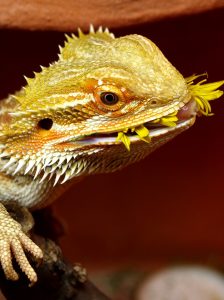
Humans need sunlight for a lot of important things, such as Vitamin D synthesis. And reptiles such as the bearded dragon?
They need it for the exact same reason. Vitamin D – and Vitamin D3, which is known as Calcitriol – allow the body to properly absorb calcium, which is then used to aid in bone development and growth.
Without a proper light, your bearded dragon won’t be able to produce this vitamin, resulting in a deficiency that could stunt their growth.
Of course, though, walking your bearded dragon on a leash isn’t the best idea, which is why it’s important to pick the right lighting for their enclosure.
When picking a light for your bearded dragon’s enclosure, there are two things to look for. First, it needs to provide warmth.
Bearded dragons, like all reptiles, are ectotherms – this just means that they cannot regulate their own body temperature and need to get their heat from an outside source.
They will also need a light that provides UVB rays to make up for the lack of sunlight they will receive.
This will help them to synthesize the right about of Vitamin D to keep their bones healthy and their growth on the right track.
If you need some help on finding an enclosure check out this article.
Choosing the Right Substrate
This is especially important for younger beardies. While eating, it’s not uncommon for your bearded dragon to ingest a small amount of their substrate – their digestive tracts are designed to handle this.
However, if you use a particularly fine substrate such as silt or small pebbles, they may ingest a harmful amount.
While gravel and pebbles are never recommended, sand is okay for adult beardies who have learned to eat better.
For younger bearded dragons, one of the most recommend substrates is newspaper.
It’s easy to clean and has no risk for impaction in the gut, though it’s not nearly as aesthetic as some other options.
By keeping your bearded dragon’s digestive tract in good health, they’ll be able to eat properly, resulting in healthy growth.
To help you we have an article on the best substrate for bearded dragons
Top Three Enclosures for Bearded Dragons
#1 Exo Terra Nano Wide Terrarium
Exo Terra is one of the most popular brands for reptile tanks and terrariums – and for good reason.
This brand’s terrariums come in a variety of styles, and this one, at 512 cubic inches, is perfect for smaller bearded dragon breeds.
Also, the Exo Terra Nano Wide has a unique front opening door so that you can easily access your beardie for everything from feeding to cleaning their enclosure to playing.
It also has an elevated, waterproof bottom that will allow you to use a substrate heater to replicate the warm ground of the desert – the bearded dragon’s natural habitat.
#2 Exo Terra Glass Reptile Terrarium
This enclosure is the same brand as the first one, but it’s much bigger.
This means that, while the Nano Wide is a good choice for smaller breeds or hatchlings, this enclosure at 12”x12”x12”, or 1728 cubic inches, is a much better choice if you have an adult bearded dragons – even some of the larger breeds.
This means that you’ll save your bearded the dragon the stress of having to switch enclosures every time they grow out of one.
It has the substrate heater and front opening door that makes caring for your bearded dragon so they can have proper growth much easier.
It has a lock, and the top is removable to make cleaning and redecorating easier.
#3 Zilla Reptile Start Kit Size 10 with Light and Heat
As you’ve seen from the information above, while having the proper enclosure is important, it’s also important to have the proper lighting and heating, and, if you’re a first time bearded dragon owner, it can be difficult to pick out the right equipment to ensure that your bearded dragon is growing properly.
That’s why the Zilla Reptile Kit, which provides nearly everything you’ll need for your lizard, is a great choice for all bearded dragon owners.
This kit includes a reflective dome feature to make sure your beardie has the proper lighting; a humidity and temperature gage so that you can make sure your dragon’s enclosure mimics their natural habitat; and a safe substrate to line the bottom of the enclosure.
Why Isn’t My Bearded Dragon Growing?
If you realize that your bearded dragon isn’t growing at the proper rate, take a second to think before panicking and phoning your veterinarian.
First, if your beardie is only an inch or two shorter than they should be, remember that growth is a variable and the numbers given above aren’t the definite standards.
Think about it this way, not all humans grow to the same height.
However, if there is a significance between the length your bearded dragon should be and the length he or she actually is, then you may need to take a step back and think about the care you’re providing.
First, think about their diet. Make sure that your beardie is getting the proper amounts of insects, fruits, and vegetable every day so that they can grow.
If that’s not an issue, consider your bearded dragon’s enclosure and lighting. If they don’t have enough light or the right type of light, they won’t grow.
This is because their body is unable to produce an adequate amount of Vitamin D, which then affects how well they can absorb the calcium from their diet.
If your bearded dragon has a calcium deficiency, they’ll lack the proper nutrition that allows their bones to develop and grow.
If neither of these seem to be the issue, then you may want to consider talking to your veterinarian to make sure that nothing is wrong with your bearded dragon.
While it could just be an issue of genetics, it’s best to make sure that your bearded dragon does not have a disease that could possibly be stunting their growth.
Final Thoughts
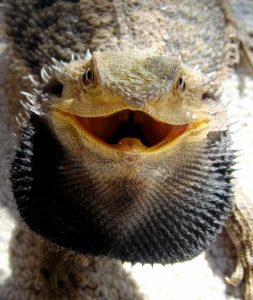 Owning a bearded dragon is a special and unique experience, especially if you’re lucky enough to raise one from birth.
Owning a bearded dragon is a special and unique experience, especially if you’re lucky enough to raise one from birth.
However, it’s important to be prepared for the responsibility of owning such an interesting little creature – and that means understanding that your bearded dragon won’t stay little forever.
With a proper diet, the right environment, and two years full of love and care, your beardie will grow to a healthy 24 inches – or maybe even bigger! – in no time.
